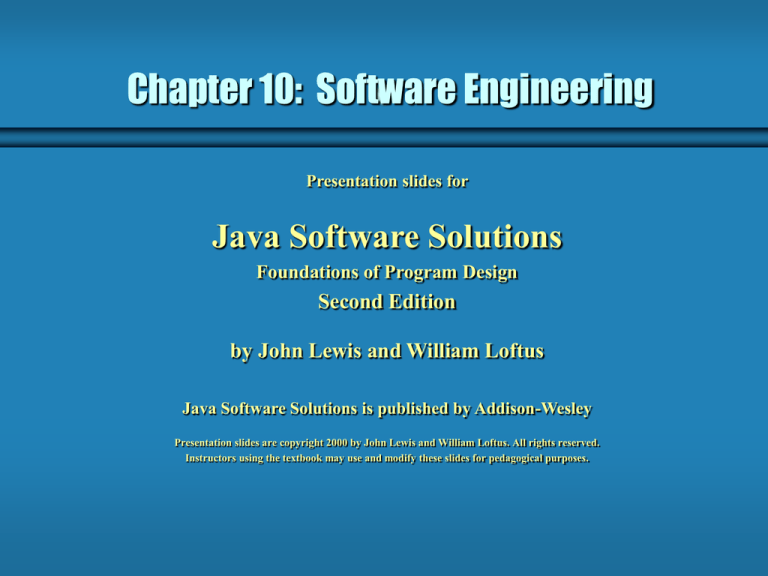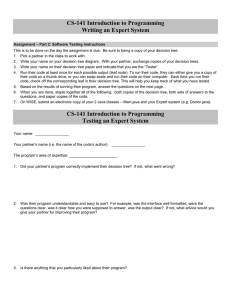
Chapter 10: Software Engineering
Presentation slides for
Java Software Solutions
Foundations of Program Design
Second Edition
by John Lewis and William Loftus
Java Software Solutions is published by Addison-Wesley
Presentation slides are copyright 2000 by John Lewis and William Loftus. All rights reserved.
Instructors using the textbook may use and modify these slides for pedagogical purposes.
Software Engineering
The quality of the software we create is a direct result of the
process we follow to develop it
Chapter 10 focuses on:
•
•
•
•
software development models
the software life cycle
linear and iterative development approaches
an evolutionary approach to object-oriented development
2
The Program Life Cycle
The overall life cycle of a program includes use and
maintenance:
Development
Use
Maintenance
3
Maintenance
Maintenance tasks include any modifications to an existing
program
It includes defect removal and enhancements
The characteristics of a program that make it easy to
develop also make it easy to maintain
Maintenance efforts tend to far outweigh the development
effort in today’s software
Small increases in effort at the development stage can
greatly reduce maintenance tasks
4
Development vs. Maintenance
Development
Use and
Maintenance
5
Development and Maintenance Effort
Development
Development
Maintenance
Maintenance
Small increases in development effort can
reduce maintenance effort
6
Development Process Models
Too many programmers follow a build-and-fix approach
They write a program and modify it until it is functional,
without regard to system design
Errors are haphazardly addressed as they are discovered
It is not really a development model at all
7
The Build-and-Fix Approach
Write
program
Modify
program
8
The Waterfall Model
The waterfall model was developed in the mid 1970s
Activities that must be specifically addressed during
development include:
•
•
•
•
Establishing clear and unambiguous requirements
Creating a clean design from the requirements
Implementing the design
Testing the implementation
Originally it was proposed as a linear model, with little or
no backtracking
It is a nice goal, but is generally unrealistic
9
The Waterfall Model
Establish
requirements
Create
design
Implement
code
Test
system
10
An Iterative Process
Allows the developer to cycle through the different
development stages
Essentially the waterfall model with backtracking
However backtracking should not be used irresponsibly
It should be used as a technique available to the developer
in order to deal with unexpected problems that may arise in
later stages of development
11
An Iterative Development Process
Establish
requirements
Create
design
Implement
code
Test
system
12
Prototype
A prototype is a program created to explore a particular
concept
More useful, time-effective, and cost-effective than merely
acting on an assumption that may later backfire
Usually created to communicate to the client:
• a particular task
• the feasibility of a requirement
• a user interface
A way of validating requirements
13
Evaluation
The results of each stage should be evaluated carefully
prior to going on to the next stage
Before moving on to the design, for example, the
requirements should be evaluated to ensure completeness,
consistency, and clarity
A design evaluation should ensure that each requirement
was adequately addressed
Prior to testing, the implementation should be give a
thorough code walkthrough
14
Testing Techniques
Generally, the goal of testing is to find errors
It is often called defect testing
A good test will uncover problems in a program
A test case includes
• a set of inputs
• user actions or other initial conditions
• expected output
It is not feasible to exhaust every possible case
15
Black-Box Testing
Black-box testing maps a set of specific inputs to a set of
expected outputs
An equivalence category is a collection of input sets
Two input sets belong to the same equivalence category if
there is no reason to believe that if one works, the other will
not
Therefore testing one input set essentially tests the entire
category
16
White-Box Testing
White-box testing is also referred to as glass-box testing
It focuses on the internal logic such as the implementation
of a method
Statement coverage guarantees that all statements in a
method are executed
Condition coverage guarantes that all paths through a
method are executed
17
An Evolutionary Development Model
We will now divide the process of design into
• architectural design - primary classes and interaction
• detailed design - specific classes, methods, and algorithms
This allows us to create a refinement cycle
Each refinement focuses on one aspect of the system
As each refinement is addressed, the system evolves
18
An Evolutionary Development Model
Establish
requirements
Architectural
design
Establish
refinement
scope
Unit and
integration test
System test
Identify classes &
objects
Identify
relationships
Implementation
Detailed
design
19
Refinement Cycle
First, we establish refinement scope to define the specific
nature of the next refinement
Such as:
• the user interface
• a particular algorithm
• a particular requirement
Choosing the most appropriate next refinement is
important and requires experience
20
Refinement Cycle
Next, we identify classes and objects
The ones that relate to the current refinement
These may overlap with other refinements
Can often define by focusing on the roles they play in the
system
Consider reusing existing classes
21
Refinement Cycle
Then we identify relationships among classes
Inheritance (is-a) relationships
The uses relationship establishes another kind of bond
between classes
• Class A uses class B in some way
• Can express cardinality
• Example: A Car has (uses) four wheels
22
Refinement Cycle
Finally, detailed design, implementation and test
Design of specific methods and their translation into code
A unit test focuses on one particular component, such as a
method or class
An integration test focuses on the interaction between
components
23
The PaintBox Project
We can explore the evolutionary development model using
a larger project
The PaintBox program will allow the user to create
drawings with various shapes and colors
After establishing the requirements, the following
refinement steps were established:
•
•
•
•
•
create the basic user interface
allow the user to draw shapes and change color
allow the user to select, move, and fill shapes
allow the user to edit the dimensions of shapes
allow the user to save and reload drawings
PaintBox Refinement 1
The first refinement establishes the basic user interface
See PaintBox.java
See PaintFrame.java
See ButtonPanel.java
See DrawingPanel.java
PaintBox Refinement 2
The second refinement allows the user to draw shapes and
change colors
See PaintBox.java
See PaintFrame.java
See ButtonPanel.java
See DrawingPanel.java
See Shape.java
See Line.java
See BoundedShape.java
See Rect.java
See Oval.java
See Poly.java








